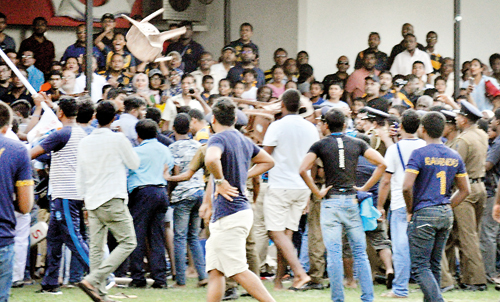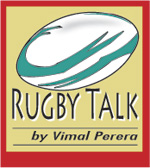School Rugby conundrum– who is responsible?
View(s):
Rugby? What is that? Let's catch chairs
Vicious fights and ugly brawls have erupted during recent School matches, while ugly scenes endanger the young. This statement is made from a larger angle, not simply the physical violence at match venues, but includes depraving the minds of the young through physical as well as mental conditioning. This involves the fabric of Schools Rugby (SR). The colossal sums of money spent by Schools could be a starting point to seek answers.
Violence has been by old boys as well as parents, leading to authorities involved asking, “Should Rugby be allowed in Schools?”. More specifically, whether there should be tournaments that lead to some thinking ‘a win is a must’. It would be sad if Rugby were to disappear from our Schools, as it is good, especially for adolescent boys. The Sports Minister has taken the first step by stopping all SR matches for a week. During this time, fingers will be pointed to many and will include the Referees (Ref), the Schools section of Rugby, as well as Sri Lanka Rugby (SLR), who may say, “We did not sanction this tournament”. At this point, it may be worthwhile to repeatedly watch Invisible Gorilla (Monkey Business) of Christopher Chabris and Daniel Simmons.
The need is to look at the root cause of the violence. The first finger is pointed at the Refs whereas, the other is the behavior of the old boys and parents as spectators, who get violent, as well as Coaches.
Abdal Haaq and others say that violence in sports is the depiction of aggressive behavior against the rules and regulations of a particular sport. Biological, Social learning and Psychological theories have been proposed to explain violence in sports.
The Biological theory suggests that violence results from the innate being of a person who perceives that it is a socially accepted way to discharge the violence built in them. I believe this was manifest in the incidents that arose during the last two weeks of SR in Sri Lanka, and a product of that culture.
The Psychological theory asserts that violence results from frustration caused by lack of achievement of certain goals. The Psychological theory holds that violence is caused by dissatisfaction. That is, violence results from the effect of a situation, and frustration is generated when the person is blocked from achieving a certain goal. In sports, particularly, frustration can result from dubious calls made by the Match Officials (MO), interference with best possible performance, boos from spectators or, jeering by players or Coaches (Abdal Haqq, 1989). The vast (filthy) amounts of money spent on the various aspects of SR, which include Coaches who are paid many times more than even the School Principal, and funded mostly by old boys, can be a contributing factor to the psychological reaction.
The Social Learning theory, on the other hand, suggests that violent behavior results from learning. In sports, the young players perceive their sports heroes as role models and, as a result, they imitate their behaviors. At the same time, Coaches, teammates and parents may also be taken to be role models and may depict support for violent playing styles. (The players are not the issue in the recent incidents). Therefore, violence in sports can occur due to young sports persons imitating the behaviors of their role models, which may suggest aggression (Abdal Haqq, 1989). Jamieson and Orr (2009) point out that one of the major social influences in sports include Coaches. Coaches depict the values and skills of sports that are esteemed by youngsters and that is why they tend to imitate these values and skills.
The case in Sri Lanka, in the last few weeks, has not been the players, but old boys, Coaches as well as parents. These, however, leave a bad breadth in the young players.
What was and has been the behavior of the Wesley Coach during this as well as other matches. Always out of seat and making gestures of various forms, which make spectators believe there is something wrong. The blame is on the inept MOs who include the Match Commissioner (MC) as well 4th and 5th who have tolerated the nonsense. In the issue of the Zahira vs St. Joseph’s match, it was about the behavior of the Coach who was expelled from the grounds by the Ref. I repeat expelled or, in lesser words, removed, as that is what is practised in the case of the behavior of others in the players enclosure, as against those in the playing field. Forget the process and the color of a card, but the issue is that you are removed from the playing enclosure. The influence of the Coach and a misplaced MC have been contributed to the happening in Kurunegala.
Research shows that violence in sports is common in competitive sports, notably Ice Hockey, Football, Rugby, Wresting, Basketball and Boxing. Violence in sports can be in the form of verbal abuse, threats, or physical injury executed by players, spectators, Coaches, parents of young players, and fans or, triggered by mass media. However, there are measures that can be implemented to prevent or curb violence in sports. The point of possibly that being one of no return is that, those who are to be role models are the culprits. Which Head of School has the backbone to tell old boy benefactors to get up, shut up and sit down?
The Refs too have to ask themselves a question as to what has contributed to the adverse image that has been etched in the minds of followers. They also have to ask themselves, “What time is right to leave an abusive relationship?” It is like a case in domestic violence. In domestic violence you suffer and hide the truth only to be beaten again. It is love that started and escalates to violence. Hence you grin and bear.
Do Refs have to grin and bear because they love the game? Some say they are paid? So is a cop, an air stewardess as well as a teller in a bank or, for that matter, anybody who does a job. A stewardess drops a drink on you or, a teller gives you a run around, do you beat them up? If you try it with a cop, it will be another story. But, in all these, there are methods and systems to handle when problems arise. Refs, like in domestic violence, get beaten but, they are back in the bed they are used to. Beaten in this dictionary is physical as well as verbal.
In Round II of the Schools League, the mayhem started with an attempt to beat another, the Ref, not beaten as some say, but attempted to beat. In my book, if a player pushes a Ref, asking him to move away, so that you can see better, it is misconduct. Extrapolate that to a spectator.
In an incident in 2014, Ben Tameifuna was suspended for 5 weeks for pushing Ref Glen Jackson. The inquiry was a result of citing, despite the Ref not taking issue with the incident. But the judiciary opined, “Having taking into account the evidence, the player’s post-match apology to the Ref, his full acknowledgement that his actions were inappropriate, I have endeavored to impose a proportionate sanction, taking into account other similar situations from overseas decisions.”
The Kandy incident is not about players but about the spectators, and the Ref should have stood on more firm ground, to put somebody behind bars, if necessary.
We, at the Sunday Times, have repeatedly spread the message that schoolboys should be allowed to enjoy the game and build friendship and character through Rugby. The game may be rough, but it teaches adolescents invaluable lessons in teamwork and self-restraint. Do the old boys contribute to this thought or, are they the pain?
 The last two weeks of SR has dropped to the depths of hooliganism. This is despite some great sportsmanship you may witness among players, on and off the field. Trinity player Reshan Bandaranayake displayed quality during the Isipathana vs Trinity match, when the Park School skipper was injured. The game had to be stopped and the ‘Mayday’ call was more important than the points. Probably, he gets the cue from Fijian Coach Raikabula who sits on the bench, very calm and observant.
The last two weeks of SR has dropped to the depths of hooliganism. This is despite some great sportsmanship you may witness among players, on and off the field. Trinity player Reshan Bandaranayake displayed quality during the Isipathana vs Trinity match, when the Park School skipper was injured. The game had to be stopped and the ‘Mayday’ call was more important than the points. Probably, he gets the cue from Fijian Coach Raikabula who sits on the bench, very calm and observant.
This injury was a result of the player clashing with his own. The immediate reaction of some adult supporters was to yell blue murder at the players as well as the Ref through a conditioned perception. The ‘Mayday’ call need to be understood by players, coaches as well as MOs. The players could have made that call, as is the protocol for a dangerous scrum collapse. Part of being inept is not knowing ‘Mayday’ call, but telling the yelling spectators that the game is continuing. When you are wired, the appropriate words to use would have been “Mayday, Mayday”.
In the midst of violence, in the Royal vs Wesley game, are 2 former players. One is a former captain and another who was shown a Red Card last year, for being involved in a fracas during a match. The DSS vs Science issue includes some who were presumably mothers and or sisters whose behaviour was appalling.
The conditioned perception is not by schoolboys, but by old boys who are either swayed, because of their involvement or, because they try to inculcate something they could not do for themselves while at school. Some are more spirited than others, because of the liquid that cheers them.
Vimal Perera is a former Rugby Referee, Coach and an Accredited Referees’ Evaluator IRB


